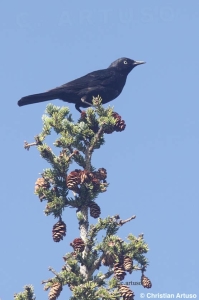 Want to know more about Areas of Interest? Find an answer to your question below, or contact International Blitz Coordinator Judith Scarl for more information.
Want to know more about Areas of Interest? Find an answer to your question below, or contact International Blitz Coordinator Judith Scarl for more information.
What is an Area of Interest (AOI)?
How did you identify and prioritize Areas of Interest (AOIs)?
How can I help if my region doesn’t have many AOIs?
What if there are no AOIs near me?
If my province or state doesn’t have many AOIs, does this mean it’s not important for Rusty migration?
Why does Canada have so few AOIs?
What is an Area of Interest (AOI)?
An Area of Interest is simply a location at which a large number of Rusties were reported during the 2014 Blitz. Since one of the Blitz objectives is to investigate the consistency of migratory timing and site use, we encourage birders to revisit Areas of Interest to see whether Rusties are using these sites again in 2015.
How did you identify and prioritize Areas of Interest (AOIs)?
Check out our Identifying Areas of Interest page for more information.
How can I help if my region doesn’t have many AOIs?
In 2015, it’s equally important for us to collect data from AOIs and from areas where we didn’t record large flocks of Rusties in 2014. Rusties move around the landscape and often rely on ephemeral habitat, so we’re always looking for new areas that they may use. Also, some regions don’t have any AOIs because we didn’t get any reports from that area, so we encourage you to explore areas that are “off the beaten path” for birders.
What if there are no AOIs near me?
No problem! Although in 2015 we’re focusing some effort on revisiting sites where large flocks congregated in 2014, it’s also critical to search in areas that were not surveyed in 2014 or areas that only supported a few Rusties last season. Bird as you normally do, and report your data to the Rusty Blackbird Spring Migration Blitz survey type in eBird. Every sighting counts, regardless of where it was collected!
Not necessarily. Some areas simply had lower Blitz participation than others, so we didn’t gather enough data to identify AOIs in that region. Also, as Rusties migrate north, larger flocks may split into smaller groups as individual birds hone their travel to reach a specific breeding area. The sparseness of international AOIs in Alaska and northern and western Canada may partially reflect the changed flocking behavior of this bird.
Why does Canada have so few AOIs?
Many areas of Canada are remote and difficult to access, so large swaths of Canada were undersurveyed during the first year of the Blitz. One of our goals in 2015 is to reach more northern and western areas of Canada, so we encourage you to go beyond your regular birding areas this year, if possible.
Also, as Rusties migrate north, larger flocks may split into smaller groups as individual birds hone their travel to reach a specific breeding area. The sparseness of international AOIs in Alaska and northern and western Canada may partially reflect the changed flocking behavior of this bird.
